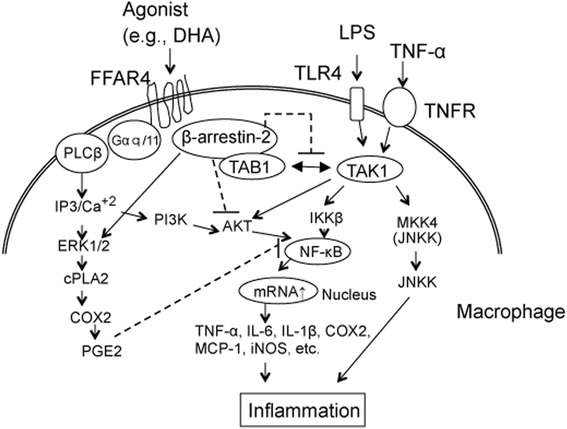Fig. 5.

Anti-inflammatory FFA4 signaling pathways in macrophages and mechanisms of action of DHA. Macrophages have FFAR4 signaling pathways that can be affected by anti-inflammatory molecules. LPS and TNF-α induce inflammatory processes following activation of TLR4 and TNFR, which subsequently activate the TAK1 complex of TAK1 and the TAB1 binding protein. Activated TAK1 phosphorylates MKK4 and induces JNK phosphorylation. TAK1 also induces the phosphorylation of IKK-β and NF-κB. NF-κB and phospho-JNK enhance mRNA expression of inflammatory mediators such as TNF-α, IL-6, IL-1β, COX 2, MCP-1 and iNOS. In contrast, FFAR4 together with DHA inhibits TAB1 dissociation and blocks potential TAK1 interactions. Activation of FFAR4 can be induced by β-arrestin-2 enhancement to inhibit its interaction with TAK1. These actions of FFAR4 block downstream activation of NF-κB and JNK to induce anti-inflammatory effects. Abbreviations: DHA, docosahexaenoic acid; FFAR4, Free fatty acid receptor 4; ERK 1/2, extracellular signal-regulated kinase 1/2; COX2, cyclooxygenase 2; TAB1, TGF-β activated kinase 1; TAK1, Transforming growth factor beta-activated kinase 1; TLR4, toll-like receptor 4; LPS, lipopolysaccharide; TNFα, tumor necrosis factor-alpha; TNFR, tumor necrosis factor receptor; MKK4; JNKK, Jun-N-terminal kinase kinase; IL-6, interleukin-6; IL-1β, interleukin-1beta; MCP-1, monocyte chemoattractant protein-1; iNOS, inducible nitric oxide synthase
